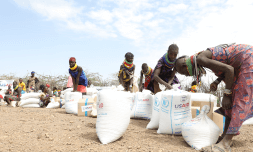The subversive rhetoric of climate activists was present at COP, but subversive decisions were not taken. Why has COP chosen the path of tokenisation of youth activists instead of listening to them?
Historically, COP has been largely white, male, severely lacking in perspectives from the Global South and, crucially, young voices.
This has resulted in years of discussions that exclude the perspectives of those who face the most risk from climate change.
This year, young climate activists from around the world were finally invited to speak at COP26. Despite the extension of this major platform, many are left wondering: why are the outcomes of these talks still so disappointing?
Is the inclusion of youth voices empowering, or performative?
Conversations about the climate crisis have evolved, from a narrow vision defined by impenetrable scientific terms and complex statistics, to centre on the human impacts. Terms such as climate justice and just transition are entering the mainstream, and attention is increasingly reorienting to highlight the inequity of both the impacts of climate change, and the solutions created to combat it.
This shift increasingly recognises the need for intergenerational climate justice, which takes into account that young people will disproportionately bear the brunt of climate change, as children born in 2020 will ‘endure seven times as many heatwaves and twice as many droughts as their grandparents.’
Young people feel this inequity, and are primed to take action, as recent studies have shown that 75% of young people find the future frightening and 65% believe their governments are failing them.
Despite these shifts in dialogue, COP discussions have been slow to catch up. In the lead up to the global meeting, there was much discussion and criticism around the inclusivity of climate discussions.
Advocates focused on the need to amplify those most affected by the climate crisis and make their voices heard – namely youth, women, marginalised, and underserved communities.
Accordingly, there appears to have been active efforts to include youth in the COP process. More youth activists have been included in official proceedings such as COY16 and the pre-COP26; as part of pre-COP26, states representatives met with almost 400 Youth Delegates, aged 15 to 29 years, from 186 countries.
Their presence in the media has also been more pronounced, as shown by the immense coverage on figures such as Greta Thunberg, inclusion of youth representatives on many panels and across social media channels.
Evidently, the growing influence of youth advocates can be felt by government and media leaders alike, as Thomas Friedman, journalist at the New York Times, expressed: “This is the first COP I’ve been to where the delegates are more afraid of the kids than the press.”
The increasing volume of youth voices is undeniable, but I am not convinced that the words are translating into action. The question isn’t whether conventional leaders are afraid, but are they truly listening?
Last week, I attended the New York Times Climate Hub alongside COP26 in Glasgow. Having been primed by the strong social media presence of youth activists, and perhaps influenced by the ‘youth-washing’ COP has been criticised of, I went in hopeful to connect with and hear from voices of my generation.
My experience there quickly revealed the disappointing truth of the event’s demographic representation. Less than five minutes after my arrival, a participant around my age approached me, congratulating me on being one of the few people there not dressed “like a boomer”. I realized we made up a small minority of young people at the event.
At this year’s COP, described by many as being one of our last chances to act, the prominent youth activists voiced their dismay in experiencing a conference which felt like a “green-washing campaign for businesses and CEOs.”




















